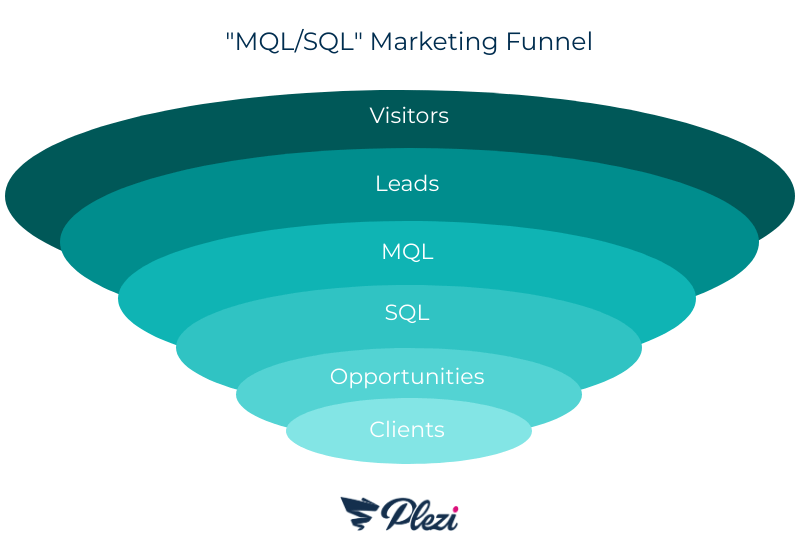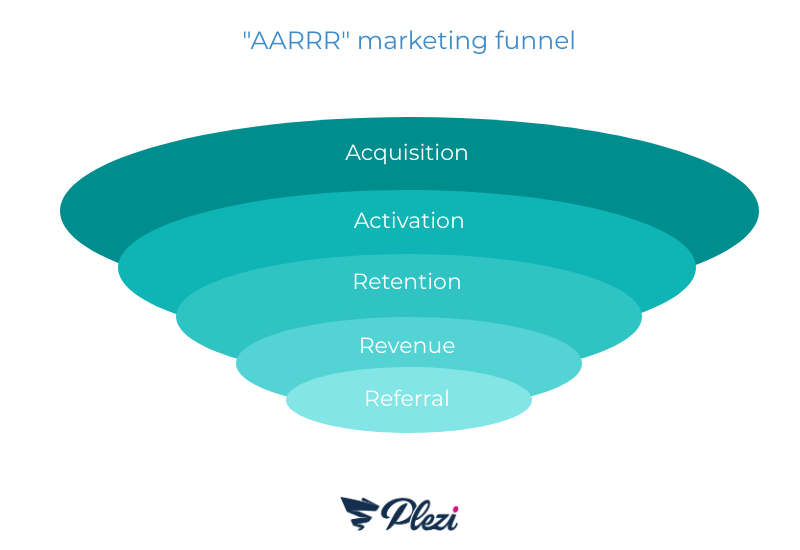The marketing funnel, also known as the purchasing cycle, forms the framework of an inbound marketing strategy. And yet, it regularly receives intense criticism due to its popularity.
So, is the marketing funnel dead?
Should we stop using it as marketers?
What are the alternatives?
Here’s our analysis.
1. The theory behind the marketing funnel
The purpose of the marketing funnel is to provide a visual, strategic and statistical image of the notion of acquisition.
The theory existed as early as the 19th century, well before anyone ever referred to “inbound marketing”.
And it forms the framework of most digital marketing strategies, providing greater visibility to the workings of marketing, from website visitors to confirmed clients:
This marketing funnel lets you calculate a multitude of interim figures and conversion rates. These are known as key performance indicators, or KPIs.
Let’s take an example:
• For 1000 visitors, I have 40 that leave their contact details on my website, which is a conversion rate of 4% of visitors into leads.
• Of these 40 people, I send half to my sales team, which is a conversion rate of 50% of leads to prospects.
• Of these 20 people, the sales team estimate that 10 meet requirements of BANT (Budget : there is money allocated to the project, Authority: the contact has the authority to make decisions or has indicated that they have it, Need: they have a definite need, Timing: it’s the right time – not two years from now). The conversion rate of prospect to qualified prospect is 50%.
• Of these 10 people, the sales team will send business proposals to 6. The conversion rate is 60% between qualified prospect and opportunity.
• Of these six people that received a quote, two will become clients. The conversion rate between opportunity and client is 33%.
This view of marketing has numerous advantages since it allows you to see at a glance where customer acquisition can be improved.
Here are a few examples:
• We only sign 5% of the companies to which we send a quote? It may be a faulty product, a problem with the sales process, problematic clauses in the contracts, or even a lack of reputation that would otherwise reassure the client.
• Only 5% of marketing prospects meet BANT requirements? This could be an issue with a marketing campaign targeting, a lack of nurturing, a misleading value proposition, poor pre-sales training of sales staff, or even poor product positioning.
• Only 1% of visitors leave us their contact details? This could be a poorly-written website, a lack of elements that reassure these visitors, non-optimised calls-to-action, or even a vague value proposition.
• All conversion rates are high, but we only have 100 visitors per month to the website? You have to open the floodgates! Work on your SEO, create content, get active on social media, launch paid-advertising campaigns, host webinars etc.
In brief, the marketing funnel is a fantastic tool that lets you turn figures into actions, by breaking down the acquisition mechanism into sub-sections.
The marketing funnel has been re-worked a million times, each time with different ideas, while always maintaining the same logic.
Just as inbound and outbound are different, acquisition is often seen as the opposite of loyalty.
It was in order to integrate loyalty that the AARRR framework was born, used by “growth hackers”. It is highly devoted to the logic of freemium:
• You start with traffic acquisition
• You encourage them to try the freemium product
• You create loyalty
• You encourage them to switch to the buying version
• You encourage them to tell their friends, parents, colleagues and grandparents.
In brief, this funnel is the only one that blends acquisition and loyalty. The aim is strategic visualisation, breaking things down, and statistical monitoring.
In particular, the funnel responds to a need for understanding between who does what to generate clients, between the marketing department and the sales team. Both departments move forward hand in hand to optimise the stages of the marketing funnel.
2. The theory of virtuous circles
Any self-respecting star has to face their critics, and the marketing funnel is no different.
So, when the creators of the inbound marketing funnel said that the tunnel was dead, making way for the “marketing flywheel”, obviously this raised a few questions… All the more when we heard that Amazon got back on the right track after having used the “Flywheel” method.
So what is this “Flywheel”?
A marketing flywheel (as defined by HubSpot) is a circular view of the marketing funnel, involving the entire company to acquire clients and generate loyalty.
The concept is interesting: the marketing, sales and customer service departments work together to generate and keep more and more clients.
Add to this the famous statistic which shows that creating a loyal client costs five times less than acquiring them, and before-you-know-it, you have a new concept!
So, is the marketing funnel dead?
No, the “marketing funnel” is not dead! The “marketing flywheel” is more suited to a new product’s positioning for larger companies whose platform now comprises three products for marketers, salespeople and customer relationship managers.
So where does famous flywheel come from?
It was Jim Collins, author of the book “Good to Great” who in 2001 developed the view of business as a machine that has a certain energy and inertia that employees will seek to put into motion.
This concept was then taken by Rand Fishkin as early as 2013, in a Whiteboard Friday” where he applied it to marketing:
Since then, Rand Fishkin has broken down this marketing flywheel concept into different marketing strategies, offering a superb visual of the efforts that a team needs to produce, and repeat, to achieve a return on investment.The concept of the marketing flywheel in this context doesn’t aim to create structure in terms of indicators. It’s about having an overview of which actions to take in order to succeed. Once the limiting factors have been identified, this allows us to take action.
If I identify that I haven’t managed to get enough links, I could then focus on this area to try to improve it. For example, by citing other businesses or influencers in an article so that they relay this article and create links to it.
This is where the virtuous circle really starts to move. For each article published, it will be easier and easier to get a return on investment.
There is no tunnel logic or any performance indicators. It’s about visualising operational tactics.
Marketing flywheels are therefore great visualisation tools for raising awareness of the investment needed before getting a result with a marketing strategy.
3. The holistic theory
And what if these views were false? What if marketing was just a set of inter-connected entities?
Have you ever watched Avatar? Each being is connected. It’s the same principle – but with marketing actions.
His view is very true, and interesting, and he advocates our one and only objective here at Plezi: having happy clients.
It’s not about isolating everything, all the time, in order to optimise it. You need to have an overview of acquisition and loyalty.
This goes against the idea of “Growth Hacking” which states that everything must be tested and optimised, without necessarily thinking of the wider repercussions of our actions.
And like any good theory, holistic marketing has been developed in opposition to the marketing funnel, described as too linear and false.
Crikey! So should we then drop our funnels?
4. What to do when you’re a marketer?
As a marketer, it’s not about sticking to one theory and applying it to the letter. No theory is perfect. They are purely concepts that illustrate the reality.
Yes, the reality is more holistic than linear. No, holistic marketing won’t help us know how to perform our marketing actions.
Yes, the notion of the marketing flywheel gives us an overview of the client-prospect relationship. No, the marketing flywheel is not the best way to map out digital marketing tactics.
Yes, the marketing funnel gives us precise indicators that we can act on, enabling us to manage marketing campaigns.
No, the marketing funnel does not take into account the whys and wherefores of value creation in the company.
So we support what Chris Barr’s says in this tweet:
Funnel > Flywheel for the vast majority of small businesses and startups. Even Hubspot is set up like a giant funnel. Flywheel work better once you have a large customer base, and even then, only in certain industries / categories.
— Chris Barr (@cbarr81) 17 mai 2019
There’s no need to complicate things for the fun of it.
Are you an SME?
Start by using the traditional marketing funnel. When your organisation becomes complex enough, between marketing, sales and customer service, it will then be time to take an interest in less linear concepts.
But whatever concept you use, it’s important to improve while relying on constructive criticism. No need to reinvent the wheel… (by Deming, created in the 1950s).






